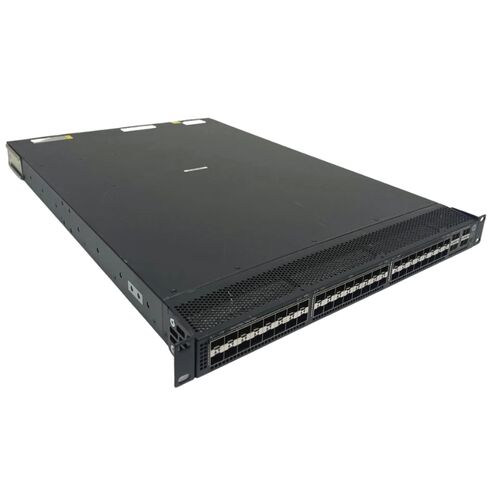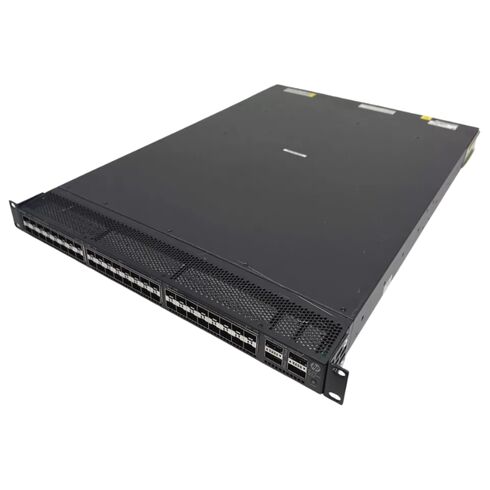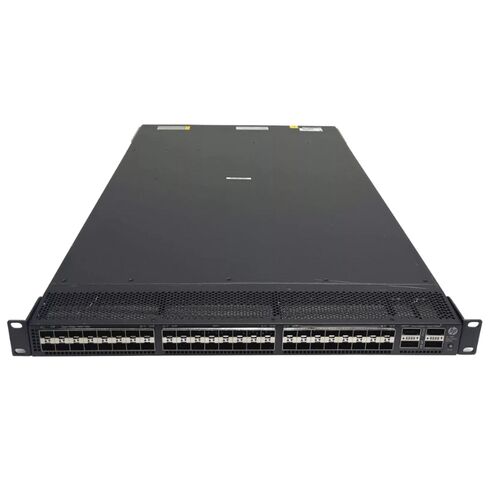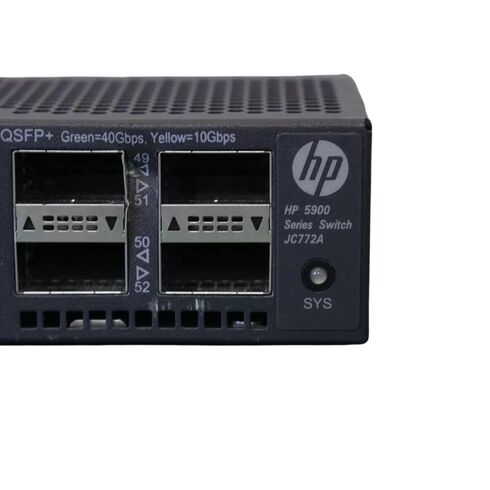JC772-61201 HPE 5900AF-48xg-4QSFP+ Switches
- — Free Ground Shipping
- — Min. 6-month Replacement Warranty
- — Genuine/Authentic Products
- — Easy Return and Exchange
- — Different Payment Methods
- — Best Price
- — We Guarantee Price Matching
- — Tax-Exempt Facilities
- — 24/7 Live Chat, Phone Support
- — Visa, MasterCard, Discover, and Amex
- — JCB, Diners Club, UnionPay
- — PayPal, ACH/Bank Transfer (11% Off)
- — Apple Pay, Amazon Pay, Google Pay
- — Buy Now, Pay Later - Affirm, Afterpay
- — GOV/EDU/Institutions PO's Accepted
- — Invoices
- — Deliver Anywhere
- — Express Delivery in the USA and Worldwide
- — Ship to -APO -FPO
- — For USA - Free Ground Shipping
- — Worldwide - from $30
Product Overview Of HPE JC772-61201
The HPE JC772-61201 5900af-48xg-4qsfp+ Switch offers exceptional management capabilities, supporting 52 expansion slots for diverse networking needs. Designed for performance-focused environments, this 1U rack-mountable switch comes without an included power supply, though it requires at least one for operation, which must be ordered separately.
Key Features
- Device Type: Managed Switch with 48 ports
- Rack Enclosure: 1U design, optimized for easy rack mounting
- Port Configuration: 48 x 1 Gigabit / 10 Gigabit SFP+ and 4 x 40 Gigabit QSFP+
- High Throughput: 952 Mpps (Million packets per second)
- Switching Capacity: Up to 1280 Gbps
Capacity and Table Size
- Routing Table Entries: Supports up to 16,000 entries for efficient routing
- MAC Address Table: Stores up to 128,000 MAC addresses
- Jumbo Frame Support: Enabled, accommodating larger packets for enhanced network efficiency
Supported Routing Protocols
This switch includes comprehensive support for protocols such as:
- OSPF (Open Shortest Path First), BGP-4, RIP-1 and RIP-2
- VRRP (Virtual Router Redundancy Protocol), OSPFv2
- Static IP Routing and ECMP (Equal-Cost Multi-Path Routing)
Remote Management Options
- Protocols: SNMP versions 1, 2c, and 3, along with Telnet and CLI support
- Security: SSH and SSH2 for secure access
Advanced Features for Networking
- Dynamic Host Configuration Protocol (DHCP) and Address Resolution Protocol (ARP) support
- VLAN (Virtual Local Area Network) Support
- Quality of Service (QoS) and DiffServ for traffic prioritization
- Broadcast Storm Control to manage excessive network traffic
- IPv6 support, ensuring future-proof connectivity
- Rapid Spanning Tree Protocol (RSTP) and Multiple Spanning Tree Protocol (MSTP)
- ACL (Access Control List) Support
- Root Guard for Spanning Tree Protocol (STP)
Standards Compliance
- IEEE 802.1D, 802.1Q, 802.1P for networking efficiency
- IEEE 802.3ad (LACP), 802.1W for redundancy and performance
- LLDP (IEEE 802.1AB) for link layer discovery protocol
Memory Specifications
- RAM: 2 GB SDRAM for fast data processing
- Flash Memory: 512 MB for storing configurations and firmware updates
Expansion and Connectivity Options
- 48 x 10Gb Ethernet (SFP+) and 4 x 40Gb Ethernet (QSFP+) ports
- 1 RJ-45 console port and high-speed USB for management
- USB Type A (4-pin) for additional connectivity
Power Specifications
- Power Device: Hot-pluggable, plug-in power module
- Installed Power Supplies: 0 (upgradable to 2 for redundancy)
- Redundancy Scheme: Supports 1+1 power redundancy (optional)
- Voltage Requirements: AC 120/230 V at 50/60 Hz
- Power Consumption: Approximately 260 Watts during operation
Number Of Ports
The HPE JC772-61201 Switches are equipped with an impressive number of ports, specifically 48. This feature sets them apart from other switches on the market and offers numerous benefits for users in terms of connectivity, scalability, and flexibility.
Enhanced Connectivity
With 48 ports, the HPE JC772-61201 Switches provide users with a wide range of options to connect various devices to their network. Whether it's servers, storage devices, or workstations, these switches ensure that there are enough ports available to accommodate all the necessary connections. This enhanced connectivity allows for seamless communication between devices, resulting in improved productivity and efficiency.
Scalability
The large number of ports in the HPE JC772-61201 Switches makes them highly scalable. As businesses grow and expand, their networking requirements also increase. With these switches, users have the flexibility to add more devices to their network without worrying about running out of ports. This scalability ensures that the switches can accommodate future growth and prevent any potential bottlenecks or limitations in the network.
Flexibility
The 48 ports in the HPE JC772-61201 Switches offer users a high level of flexibility in designing their network infrastructure. They have the freedom to connect multiple devices simultaneously and configure their network in a way that best suits their specific needs. Whether it's setting up VLANs, implementing link aggregation, or creating redundant connections, these switches provide the necessary flexibility to meet diverse networking requirements.
Efficient Resource Utilization
The availability of 48 ports allows users to distribute network resources efficiently. By connecting devices directly to the switch instead of relying on cascading multiple switches, users can eliminate unnecessary latency and bottlenecks. This ensures that each device has dedicated bandwidth and reduces the chances of network congestion. Efficient resource utilization leads to improved network performance and a better overall user experience.
Reduced Maintenance and Management Efforts
Having 48 ports in a single switch reduces the number of devices that need to be managed and maintained. Instead of dealing with multiple switches, users can consolidate their network infrastructure into a single unit, simplifying the management process. This reduces the efforts required for troubleshooting, firmware updates, and general maintenance tasks. Additionally, it streamlines cable management and reduces clutter, making it easier to identify and resolve any potential issues.
Cost-Effectiveness
The HPE JC772-61201 Switches' 48 ports offer cost-effectiveness in terms of hardware investment. Instead of purchasing multiple switches to accommodate a large number of devices, users can opt for a single switch with ample ports. This reduces upfront costs and eliminates the need for additional rack space, power supplies, and cooling solutions. The cost savings can be significant, especially for businesses with extensive networking requirements.
Future-Proofing
Investing in a switch with 48 ports ensures future-proofing for businesses. As technology advances and networking demands increase, having a sufficient number of ports becomes crucial. The HPE JC772-61201 Switches' 48 ports provide users with the assurance that their network infrastructure can handle future growth without requiring immediate upgrades or replacements. This future-proofing saves both time and money in the long run.
Overall, the HPE JC772-61201 Switches' 48 ports offer enhanced connectivity, scalability, flexibility, efficient resource utilization, reduced maintenance efforts, cost-effectiveness, and future-proofing. Whether it's for small businesses or enterprise-level organizations, this feature provides users with a solid foundation for building a reliable and high-performing network infrastructure.
Number Of QSFP Ports
In addition to the impressive 48 ports, the HPE JC772-61201 Switches also feature 4 QSFP (Quad Small Form-factor Pluggable) ports. These ports offer unique benefits and play a crucial role in certain networking scenarios where high-speed data transfer and connectivity are essential.
High-Speed Data Transfer
The 4 QSFP ports in the HPE JC772-61201 Switches provide users with high-speed data transfer capabilities. QSFP technology supports data rates of up to 40 Gigabits per second (Gbps), allowing for fast and efficient transmission of large amounts of data. Whether it's transferring large files, streaming high-definition content, or running bandwidth-intensive applications, these ports ensure that data flows seamlessly without any bottlenecks.
Aggregation and Link Expansion
The QSFP ports in the HPE JC772-61201 Switches can be used for link aggregation and expansion purposes. Link aggregation, also known as port trunking or bonding, combines multiple physical connections into a single logical connection. This increases both bandwidth and redundancy, providing higher network availability and improved performance. The QSFP ports enable users to aggregate multiple connections from other devices or switches, maximizing network capacity and efficiency.
Interconnectivity with High-Speed Devices
Certain devices, such as high-performance servers, storage arrays, or network switches, require high-speed connectivity to deliver optimal performance. The QSFP ports in the HPE JC772-61201 Switches cater to these requirements by allowing direct connections to such devices. This eliminates the need for additional adapters or converters and ensures that high-speed devices can operate at their full potential without any compatibility issues.
Support for Fiber Optic Connections
QSFP ports support both copper and fiber optic connections, providing users with flexibility in choosing the appropriate medium for their networking needs. Fiber optic connections offer numerous advantages over traditional copper connections, including longer distances, higher bandwidth, and immunity to electromagnetic interference. The QSFP ports enable users to take advantage of these benefits and build a robust and reliable network infrastructure.
Future-Proofing
Similar to the 48 ports, the 4 QSFP ports in the HPE JC772-61201 Switches contribute to future-proofing the network infrastructure. As data transfer requirements continue to increase, having high-speed ports like QSFP ensures compatibility with future devices and technologies. This future-proofing allows businesses to stay ahead of the curve and adapt to evolving networking demands without significant hardware upgrades or replacements.
In conclusion, the 4 QSFP ports in the HPE JC772-61201 Switches provide high-speed data transfer capabilities, aggregation and link expansion options, interconnectivity with high-speed devices, support for fiber optic connections, and future-proofing. These features make these switches suitable for demanding environments where speed, scalability, and reliability are paramount.













